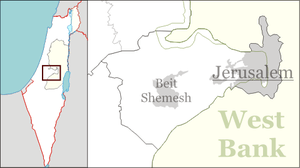Tzova
| Tzova צובה | |
|---|---|
|
| |
 Tzova | |
| Coordinates: 31°47′3.48″N 35°7′10.55″E / 31.7843000°N 35.1195972°ECoordinates: 31°47′3.48″N 35°7′10.55″E / 31.7843000°N 35.1195972°E | |
| District | Jerusalem |
| Council | Mateh Yehuda |
| Affiliation | Kibbutz Movement |
| Founded | October 19, 1948 |
| Founded by | Palmach soldiers |
| Population (2007) | 578 |
| Website | www.tzuba.org.il |
Tzova (Hebrew: צוֹבָה), also Palmach Tzova (Hebrew: פלמ"ח צובה) is a kibbutz in the Judean Hills, on the outskirts of Jerusalem, Israel.[1] It is under the jurisdiction of the Mateh Yehuda Regional Council. Tzova can also be written as 'Tzuba', 'Tsuba' or 'Zova'. As of September 2014 the population was as follows:
- Kibbutz Members : 266
- Candidate members : 19
- Children : 150
- Youngsters aged 18 – 28 (including National Service): 93
- Other residents : 81
- Total : 609 [2]

History
Tel Tzova was the site of an ancient Jewish settlement in the days of King David according to 2 Samuel 23:36. According to some scholars it can be dated back even further to the time of Joshua Bin-Nun, based on Joshua 15:59 in the Septuagint.
In 1170, a Crusader fortress, Belmont, was built there to guard the route to Jerusalem. Belmont was conquered by Saladin in 1191.
The adjacent Arab village of Suba was the scene of fierce fighting during the 1948 Arab-Israeli War due to its strategic location overlooking the road to Jerusalem. In late 1947 and early 1948, irregular forces of the Egyptian Muslim Brotherhood stationed in Suba repeatedly attacked Jewish traffic on the main highway from Tel Aviv to Jerusalem. The village was conquered by the Palmach during the night of July 12–13 as part of Operation Danny. Most of the inhabitants fled before the fighting and did not return.[3] Most moved to Kalandiya or Amman in Jordan, although some moved only 1 km away to the nearby village of Ein Rafa - where they and their descendants live to this day as Israeli citizens.[4]
In October 1948 a group of Palmach veterans established Kibbutz Misgav Palmach 1 km south of Suba, which was later renamed Palmach Tzova.[5]
Economy
The kibbutz's main income comes from its glass factory: "Oran Safety Glass"[6] which produces laminated, tempered and bulletproof security glass.[7][8] There is also a hotel overlooking the Jerusalem Hills, a children's amusement park ("Kiftzuba"), orchards, vineyards, chocolate workshop and more.[9] Tzuba's boutique winery produces a variety of red and white wines, some of which have won gold and silver medals in international competitions.[10] The kibbutz also hosts a residential Hebrew language ulpan.[11] Other sources of income - located away from the kibbutz - are the dairy farm (located in Kibbutz Tzora) and cotton fields. In addition, since Kibbutz Tzuba is based on socialist principles, the salaries of kibbutz members who work independently in the city are automatically paid into the communal purse.
Communal Life
Tzuba is a close-knit community and the majority of members work on the kibbutz. There is a communal dining room and laundry, although not all kibbutz members use these services. Property is owned by the kibbutz and decisions made by members' committees or general meetings. Most kibbutz children attend the same schools.
Cultural events are organized for festivals and other occasions.
Archaeology
In 1999, a cave believed to have been the cave of St. John the Baptist was discovered by Reuven Kalifon during archaeological excavations in the area of the kibbutz orchards, not far from Ein Karem, St. John's traditional birthplace.[12] In the 4th and 5th century CE, the cave was sanctified and used by Byzantine monks as a Christian holy place. On its walls are some of the earliest drawings known in local Christian art.[13] Structures outside the cave date to the Hellenistic period (2nd century BCE) and indicate that the cave was used as both a water reservoir and a place for bathing. Water was collected from the valley and channeled into the cave via a water-filtering basin. A sluice allowed some of the water to be channeled from the filtering basin into the fields.[14]
Archaeologists discovered a flight of 7 steps leading to an underground, man-made rectangular pool of water. Thousands of pottery shards, possibly the remnants of small water jugs used in the baptismal ritual, were found at the site. [15]
See also
References
| Wikimedia Commons has media related to Tzova. |
- ↑ http://www.tzuba.org.il/
- ↑ Kibbutz Tzuba Newsletter No. 1594, 14.11.2014
- ↑ Morris, Benny (2004). The Birth of the Palestinian Refugee Problem Revisited. Cambridge University Press. p. 436. ISBN 978-0-521-00967-6.
- ↑ "Suba - Remembering a Village in the Jerusalem Area." (م. س. م. رومان) written by M.S.M. Rumman published: 2000.
- ↑ Khalidi, Walid (1992), All That Remains: The Palestinian Villages Occupied and Depopulated by Israel in 1948, Washington D.C.: Institute for Palestine Studies, ISBN 0887282245
- ↑ http://osg.co.il
- ↑ https://www.youtube.com/watch?v=HvalipMDvb0
- ↑ Search for the Sacred
- ↑ http://www.tzuba.co.il/home/
- ↑ Kibbutz website in English
- ↑ Ulpan
- ↑ Ulpan
- ↑ http://www.talewins.com/worldtravel/indianajones.htm
- ↑ http://www.tfba.org/projects.php?projectid=3
- ↑ Cave called John the Baptist